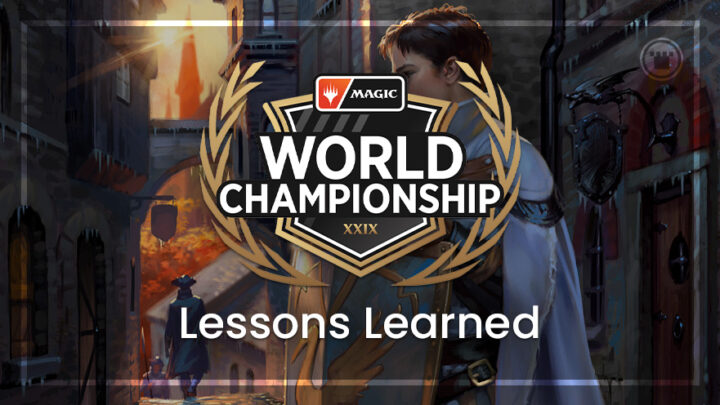More than 100 of the best Magic players in the world gathered in Las Vegas for the 2023 World Championship last weekend to compete in a tournament split between Wilds of Eldraine Draft and Standard Constructed. And as with the conclusion of any tournament, there are lessons to be learned from World Championship XXIX.
What expectations did players and spectators have going into the event? Did those expectations become reality? Did the tournament have any surprises? Let’s answer these questions and see what Worlds taught us.
The Lead Up
In the weeks leading up to Worlds, Esper and Golgari Midrange decks seemed like the place to be. Mono Red and Mono White Aggro were on the radar, but on the downswing in the face of the two Midrange decks.
Meanwhile, Team Handshake had been running the streets this year at the premier level of events, placing members in top 8s seemingly with ease — even sending some home with trophies. Nathan Steuer, Javier Dominguez, Simon Nielsen, Anthony Lee and Karl Sarap were in attendance at Worlds looking to continue their dominance.
Steuer and Dominguez were vying to join Shahar Shenhar as two time world champions, while Nielsen had the Player of the Year race on top of everything else.
The Battlefield
Once players submitted deck lists, we got a clear picture of the metagame. Let’s take a look to see exactly how players approached this tournament:

Esper Midrange was one of the decks to beat coming into the tournament and ended up being the most played deck. This was no surprise given the deck plays a proactive game with some of the best cards in Standard — including Raffine, Scheming Seer and Sheoldred, the Apocalypse.
Somewhat surprisingly Mono Red aggro showed up with 10 copies, making it the second most played deck in the tournament. Struggling with Esper and Golgari, it seems the Red players were taking aim at the Domain Ramp, Esper Control and Rakdos Reanimator decks that were poised to be tough matchups for the Midrange decks.
However, a slew of other decks also showed up to beat the Black midrange decks, so let’s take a look at a couple of them.
Domain Ramp

Reid Duke, Willy Edel and other high caliber players played Domain Ramp. When asked about the archetype, Edel said, “If players like Reid Duke and myself are playing Domain and not black/green, you know the deck is busted.”
Reid shared a similar sentiment with his fellow typically-Golgari loving peer. This demonstrated that, despite the presence of a viable Black/Green Midrange deck, Domain’s ability to go well over the top was too alluring to resist.
The name of the game with this deck is to ramp your way to seven mana with Topiary Stomper and Invasion of Zendikar. Atraxa, Grand Unifier and Herd Migration are the big payoffs for making it to this benchmark.
Both Atraxa and Herd Migration are basically lights out against Golgari and Esper if Domain is at anything resembling an even board position. And despite not winning the event, plenty of games demonstrated Domain’s potential.
Mono Blue Cauldron

Mono Blue and Simic Cauldron came out of nowhere as a combo deck built around the new and powerful artifact Agatha’s Soul Cauldron. Omen Hawker, Sleep-Cursed Faerie, Training Grounds and Realm-Scorcher Hellkite deal infinite damage, and you can move those abilities around thanks to Agatha’s Soul Cauldron.
Golgari Midrange, the most interactive archetype at the event, would struggle to keep up with removal spells against Cauldron because, given enough time, Cauldron makes any creature into a self contained combo if you have a Training Grounds in play.
Mono Blue Cauldron didn’t have the best weekend, largely due to Esper Midrange being the most played deck. Aggression backed up with counterspells is tough for a fairly linear combo deck to beat. However, if Golgari had ended up edging out Esper in popularity, things could have definitely gone differently for the Cauldron players.
What Worked?
Decks are often the main focus of events like these, but every list is made up of individual cards. Given that fact, there were a handful of cards that either weren’t played as much as they should have been or over-performed in their slots.
Farewell wasn’t a heavily registered card, but whenever it showed up on camera, it looked incredible. Between Agatha’s Soul Cauldron, Up the Beanstalk, Leyline Binding, Wedding Announcement, Virtue of Persistence, Virtue of Loyalty, Oni-Cult Anvil and more, there were a lot of incidental artifacts and enchantments at the World Championship this year — and that doesn’t even cover any graveyard synergies.
Farewell answers everything, except planeswalkers, cleanly. Plus Farewell is modal, so you can tailor it to whatever the current board needs. I’d expect to see more Farewells in Standard decks in the coming weeks.
Make Disappear may not have seen much play in the Esper Legends deck, but we saw a lot of the powerful counterspell in Esper Midrange and Azorius Soldiers. Team Handshake, the best team in the game right now, identified Make Disappear as a good place to be, and that they wanted to bring the best Make Disappear deck this weekend.

Azorius Soldier is an aggressive deck backed up by Make Disappear and Zephyr Sentinel, built to target the Domain Ramp deck that Team Handshake must have anticipated would show up to beat up on the black midrange decks.
Soldiers can also hold their own against Mono Red and Mono White Aggro by virtue of being slightly larger than those decks. Meanwhile, they still packed enough disruption to get the job done against Golgari and Domain.
But Esper Legends isn’t what Azorius wanted to see across the table, as that list just outclassed the Soldiers on the battlefield.


Speaking of Esper, I’d say it worked given the final was an Esper Legends vs an Esper Midrange matchup. But there are two things that stood out to me about the Esper decks.
First, Dennick, Pious Apprentice punched well above its weight class this weekend. A cheap body that blocks well with lifelink was perfect against the aggressive decks, demanding an answer or it would stonewall the battlefield. Dennick also shuts down the ability to target cards in graveyards, which was bad news for the Cauldron players and the reanimator players alike.
Otherwise, Disturb makes Dennick a great option against interactive decks without Leyline Binding, as it is a built in two for one. That’s also not to mention that Dennick, Pious Apparition generates clues when creatures go to the graveyard. It is possible that we see Dennick’s stock rise in the coming weeks.
Second, Sheoldred, the Apocalypse is somehow a hotly contested card in black midrange decks in Standard. Just look at the finals: Jean-Emmanuel Depraz played the full four copies of the incredibly powerful Phyrexian.
With the tournament pedigree that Sheoldred has, cutting to any less than three copies of Sheoldred is looked at with skepticism. However, many players showed up with one or zero copies.
There are some matchups that Sheoldred will cold by itself. A turn four Sheoldred against any of the aggro decks (provided you did anything else before that turn) would almost always slam the door on that game.
Even in the midrange mirrors, Sheoldred asks the opponent if they have a removal spell or a Sheoldred of their own. And if they don’t, they’re very likely to lose the game.
An unchecked Sheoldred is a nightmare to get into combat with because the defender has to consider double blocking with the fear of getting blown out by a removal spell. Meanwhile, Racing is off the table because Sheoldred deals so much damage, all while gaining its controller a constant stream of life.
The good players who are winning consistently are playing the best cards, so it may be wise to put one of the best cards in standard into your black midrange decks.
End Step
This was a whirlwind of a weekend, with so many storylines. Nielsen narrowly edged out Duke for Player of the Year and notched his third consecutive premier event top 8. Team Handshake still dominated with both Nielsen and Lee making top 8, while Dominguez came close.
Also, Standard actually looked good this weekend, and I’m hoping it stays that way with the longer rotation cycle for the upcoming Standard RCQ season in December!
Congratulations to all of the competitors for qualifying for the World Championships — an incredible feat in its own right. But a special congratulations to the top 8: Depraz, Kazune Kosaka, Nielsen, Lee, Duke, Greg Orange, Edel and Lorenzo Terlizzi. The most congratulations are in order to Depraz, though, for one upping his world championship runner up finish with a trophy!
As always you can find me on Twitter @RappaciousOne or on BlueSky at @RappaciousOne.bsky.social for questions, comments or feedback. Until next time everyone, be well!

Michael Rapp is a Modern specialist who favors Thoughtseize decks. Magic sates his desire for competition and constant improvement.




